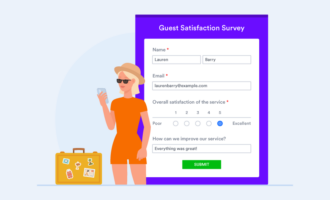Tips for creating qualitative surveys
- Start with clear goals
- Give your audience the option to not answer a question
- The shorter the question, the better
- Allow for the unexpected
- Take advantage of the free online tools available
Most surveys don’t require a lot of thought to answer. Typically, respondents just select their answers from either a scale of 1–10 or a list of multiple-choice options.
With qualitative surveys, on the other hand, the objective is much different. Using open-ended questions, these surveys seek to dive deeper on a particular topic and find out why a person holds an opinion, not just what that opinion is.
As such, survey makers need to take a thoughtful, nuanced approach to writing open-ended questions. Thankfully, there are plenty of tools available for the resourceful pollster to help them craft questions and host surveys.
The basics of qualitative surveys
At their most basic, qualitative surveys ask open-ended questions as opposed to asking respondents to select their answers from a group of pre-written options. Think of qualitative surveys like the essay portion of an exam; responses are much more subjective and open to interpretation.
While they limit your ability to gather quantifiable data, qualitative questions can help you identify the biggest benefits and issues your customers may experience when using your product or service. While these questions take longer for your respondents to answer, they also give them the opportunity to voice any and all concerns, rather than forcing them to choose a pre-written answer that may not necessarily fully represent how they feel. Plus, you’ll know that those who do respond to your survey are dedicated customers, as it takes commitment to answer these types of questions.
You can use the insight you gain from qualitative surveys to inform projects like future product launches, since you’ll have a better understanding of what drives the group you’re collecting feedback from in the first place.
Qualitative surveys vs quantitative surveys
At the other end of the survey spectrum are quantitative surveys. Understanding this kind of survey helps in understanding the purpose behind a qualitative survey. Remember those easy-to-answer number scale and multiple-choice survey questions we mentioned? These are quantitative questions, and there’s a reason why you’d want to use them.
In quantitative questions, you can easily assign a number value to each answer (that’s especially true for questions with a 1–10 scale) and plug those values into a graph for a visual representation of how respondents feel about an issue. Where qualitative surveys provide nuance in opinion, quantitative surveys offer collective feedback that you can turn into hard data.
Both types of surveys are useful for collecting information from an audience, but they serve different purposes. Many pollsters will use both at different points to gather feedback that’s as varied as possible about a certain issue, product, or service.
5 tips for building great qualitative surveys
Here are some best practices you can follow to ensure your qualitative survey is as insightful and accessible as possible.
- Start with clear goals.
Because qualitative surveys rely on open-ended questions, you need to phrase them carefully to get the answers you want. That doesn’t mean you should ask leading questions, though. Rather, you should write questions that respondents can only answer in a way that touches on the topics you’re polling about. Otherwise, you may end up with a potpourri of responses.
- Give your audience the option to not answer a question.
This may seem odd, but giving people a “not applicable” choice on a question helps you weed out responses that may not be fully thought-out, and it allows your audience to avoid questions that don’t apply to them. By allowing respondents to only answer questions they’re interested in or those that are relevant to them, you can more easily parse the data and gather more accurate information.
- The shorter the question (and survey), the better.
When someone is filling out an optional survey, they may have a strong urge to quit the process when a question is too long or complicated. This goes double for surveys that aren’t up-front about their length or simply have too many questions.
- Allow for the unexpected.
It can be tempting to write questions that lead your respondents to a particular conclusion or, at least, to a particular context. By including questions that let your audience take charge in your survey, you may find their answers surprising and inspiring. Leave space for them to input their own ideas.
- Take advantage of the free online tools available.
Creating your own surveys and then finding a platform to support them isn’t the most efficient way to run a qualitative survey. Why reinvent the wheel, right? Instead, rely on services like online form builder Jotform to lay the groundwork for you with hundreds of survey templates to choose from.
Flexibility with Jotform surveys
You can use Jotform surveys for both qualitative and quantitative research, customizing the content as you see fit while leaving the coding and hosting to Jotform. You can even customize your surveys with your own branding and color scheme.
Take some time to look through the available survey templates and choose the right one for your next qualitative survey. The platform even has helpful resources on how to create a survey with them.
Surveys are some of the most powerful tools a business or organization can use to decide which direction to take next and the best way to continue growing. By making choices based on direct feedback, you’ll be far less likely to stray off course.
Photo by Joshua Sun on Unsplash






































































































Send Comment: